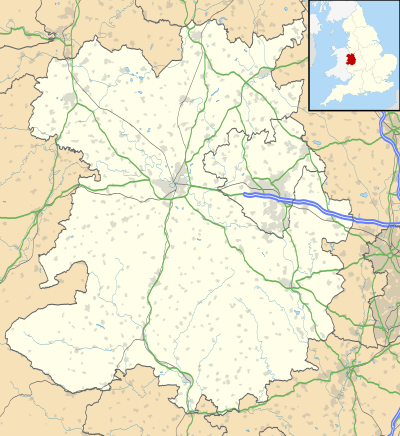Feathers Hotel, Ludlow
The Feathers Hotel, The Bullring, Ludlow, Shropshire is an historic inn. Its imposing half-timbered frontage was constructed in 1619, over an earlier core, for a local lawyer, Rees Jones.[1] John Newman describes the hotel as a "prodigy" of Tudor architecture and it is noted for its Jacobean furnishings. It is a Grade I listed building, listed on 15 April 1954,[2][3] and is one of approximately 500 listed buildings in Ludlow, but one of its best known.[4][5]
| Feathers Hotel | |
|---|---|
 | |
 | |
| General information | |
| Location | 21 Bull Ring, Ludlow, Shropshire, England |
| Coordinates | 52°22′7″N 2°43′3″W |
| Completed | 1619 |
| Website | |
| Official site | |
Etymology
The timber facade has motifs of Prince of Wales's feathers, from which the inn's name derives.[1]
History
The building was completed in 1619 by Rees Jones, practising attorney from Pembrokeshire who had come to Ludlow to pursue his profession at the “Council of the Marches”.[3] The Cambrian Archaeological Association said in 1899, "this is much the most picturesque of all the half-timbered houses now remaining in Ludlow. In adapting it for use as a hotel, none of the old work has been tampered with."[6] The New York Times reportedly named it the "most handsome inn in the world".[7]
Architecture

The half-timbered black and white building was listed on 15 April 1954.[2][8] The front dates to the early 17th century, with a timber-frame and plaster; brick; double-depth plain tile roof, with three gables to front and brick end stacks to rear.[2] The hotel is three storeys high excluding the cellar, and has a three-bay plan, with bays which are moulded and carved mullions and transoms, with cast diamond glazing. The central entrance contains a porch with pillars and consoles supporting the 1st floor balcony.[2] The studded plank door is the original.[2] The ground floor room to right of entrance has panelling, mantelpiece and wall paintings and rooms on the first floor have panelling, plaster ceiling and over mantel, with rustic bare Elizabethan timber-framing and ceiling beams in several of the rooms.[2] The dark oak paneling reaches the ceiling of the dining room. Its diamond paneled windows open towards churches and Ludlow Castle. The mantle pieces are richly carved. Another feature is that the chimes of the church tower are clearly heard in the hotel rooms, which also ring at midnight and 4 AM.[8] As of 2007, the hotel had 40 en-suite rooms.[4] Twelve of the rooms were renovated in the late 2000s in the Georgian style and several of the rooms contain four poster beds.[7] Among the other features noted in the hotel is the lock plate with inscriptions of the name of Rees Jones. The lintels of the doors have fine carvings. When it was converted to an inn in 1670 alterations made included a balcony which was added for “electioneering.”[3]
Robert Pancheri, famous for his wooden architectural sculptures and carvings for churches and public buildings was involved in the restoration of wooden carvings of Feathers Hotel. He received many awards for his works, which included Civic Trust Award 1970 for his work for the Feathers Hotel.[9]
Rivalry with The Bull
On the opposite side of the street is the Bull Hotel and the two hostelries partake in a tug-of-war competition every Boxing Day across the street itself.[10]
References
- Newman/Pevsner 2006, pp. 375-6.
- "Feathers Hotel, Ludlow". British Listed Buildings. Retrieved 4 July 2011.
- David Hunter (31 May 2004). The Shropshire hills: a walker's guide. Cicerone Press Limited. pp. 147–. ISBN 978-1-85284-427-1. Retrieved 7 July 2011.
- Fullman, Joseph (1 June 2007). Take the Kids England, 3rd. New Holland Publishers. p. 558. ISBN 978-1-86011-353-6. Retrieved 5 July 2011.
- "Feather's Hotel Ludlow". Shropshire Life. Retrieved 6 July 2011.
- Skinner, John (1899). Archaeologia cambrensis. Cambrian Archaeological Association, W. Pickering. p. 169. Retrieved 4 July 2011.
- Porter, Darwin; Prince, Danforth (2007). Frommer's England 2008. Frommer's. p. 519. ISBN 978-0-470-13819-9. Retrieved 5 July 2011.
- Thomas D. Murphy (September 2010). British Highways And Byways From A Motor Car. BoD – Books on Demand. pp. 44–. ISBN 978-3-86741-447-0. Retrieved 5 July 2011.
- George Thomas Noszlopy; Jeremy Beach; National Recording Project (Public Monuments and Sculpture Association) (1998). Public sculpture of Birmingham: including Sutton Coldfield. Liverpool University Press. pp. 201–. ISBN 978-0-85323-682-5. Retrieved 5 July 2011.
- Hobbs, Tony (2002) The Pubs of Ludlow and neighbouring villages p 92
Sources
- Newman, John; Pevsner, Nikolaus (2006). Shropshire. The Buildings of England. New Haven and London: Yale University Press. ISBN 0 300 12083 4.